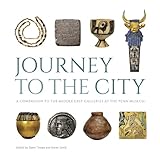Journey to the City : A Companion to the Middle East Galleries at the Penn Museum / ed. by Steve Tinney, Karen Sonik.
Material type: TextPublisher: Philadelphia : University of Pennsylvania Press, [2019]Copyright date: 2019Description: 1 online resource (440 p.) : 423 color illusContent type:
TextPublisher: Philadelphia : University of Pennsylvania Press, [2019]Copyright date: 2019Description: 1 online resource (440 p.) : 423 color illusContent type: - 9781931707176
- Anthropological museums and collections -- Pennsylvania -- Philadelphia -- Catalogs
- Archaeological museums and collections -- Pennsylvania -- Philadelphia -- Catalogs
- Cities and towns -- Middle East -- History
- Urbanization -- Middle East -- History
- SOCIAL SCIENCE / Archaeology
- African Studies
- Archaeology
- Asian Studies
- Middle Eastern Studies
- 307.760956 23
- HT147.M628 J68 2019
- online - DeGruyter
| Item type | Current library | Call number | URL | Status | Notes | Barcode | |
|---|---|---|---|---|---|---|---|
 eBook
eBook
|
Biblioteca "Angelicum" Pont. Univ. S.Tommaso d'Aquino Nuvola online | online - DeGruyter (Browse shelf(Opens below)) | Online access | Not for loan (Accesso limitato) | Accesso per gli utenti autorizzati / Access for authorized users | (dgr)9781931707176 |
Frontmatter -- Contents -- Dedication -- Donor Acknowledgments -- Director's Preface -- Acknowledgments -- Map of the Ancient Middle East -- Timeline of Key Periods and Developments -- 1. The New Middle East Galleries at the Penn Museum -- 2. The Geography and Agriculture of the Middle East -- 3. The First Cities -- 4. Religion and the Gods -- 5. A View from the Highlands -- 6. Nomads -- 7. The Ancient Near Eastern City: 2100–500 BCE -- 8. The Royal Cemetery of Ur -- 9. Hasanlu -- 10. The City under Empire: Nippur from 1000 BCE to 800 CE -- 11. The Medieval and Early Modern Islamic and Persianate City -- 12. The Modern City -- 13. Epilogue: The Middle East and Globalization -- Appendix: Timeline of Penn Museum Excavations in Iraq and Iran -- References -- Author Biographies -- Figure Credits
restricted access online access with authorization star
http://purl.org/coar/access_right/c_16ec
The Penn Museum has a long and storied history of research and archaeological exploration in the ancient Middle East. This book highlights this rich depth of knowledge while also serving as a companion volume to the Museum's signature Middle East Galleries opening in April 2018. This edited volume includes chapters and integrated short, focused pieces from Museum curators and staff actively involved in the detailed planning of the new galleries. In addition to highlighting the most remarkable and interesting objects in the Museum's extraordinary Middle East collections, this volume illuminates the primary themes within these galleries (make, settle, connect, organize, and believe) and provides a larger context within which to understand them.The ancient Middle East is home to the first urban settlements in human history, dating to the fourth millennium BCE; therefore, tracing this move toward city life figures prominently in the book. The topic of urbanization, how it came about and how these early steps still impact our daily lives, is explored from regional and localized perspectives, bringing us from Mesopotamia (Ur, Uruk, and Nippur) to Islamic and Persianate cites (Rayy and Isfahan) and, finally, connecting back to life in modern Philadelphia. Through examination of topics such as landscape, resources, trade, religious belief and burial practices, daily life, and nomads, this very important human journey is investigated both broadly and with specific case studies.
Mode of access: Internet via World Wide Web.
In English.
Description based on online resource; title from PDF title page (publisher's Web site, viewed 26. Aug 2024)


